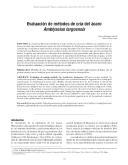| dc.contributor.author | Rodríguez M, H. | |
| dc.contributor.author | Ramos L, M. | |
| dc.date.accessioned | 2015-03-19T21:31:45Z | |
| dc.date.available | 2015-03-19T21:31:45Z | |
| dc.date.issued | 2003 | |
| dc.identifier | 466514 | es_ES |
| dc.identifier.issn | 1659-008 | es_ES |
| dc.identifier.uri | https://repositorio.catie.ac.cr/handle/11554/6277 | |
| dc.description | 4 ilus. 4 tab. 30 ref. | es_ES |
| dc.description.abstract | Se evaluaron diferentes métodos de cría de Amblyseius largoensis (Muma) en condiciones de laboratorio, dado su potencial como agente de control biológico de Polyphagotarsonemus latus (Banks). Se determinó que el método de supervivencia de hojas de papa infestadas con ácaro blanco es el más favorable para obtener las poblaciones necesarias para realizar estudios de laboratorio mientras que, para la reproducción masiva, la opción más adecuada es el método de las bandejas de zinc galvanizado con soporte inerte. Para el mantenimiento del pie de cría en época óptima para la reproducción del fitófago sobre hojas de papa, se debe utilizar el método de supervivencia de hojas sobre sustrato inerte con P. latus y polen de maíz, y en época no óptima, se debe usar el método de supervivencia de hojas de toronja infestadas con Panonychus citri (McGregor). Se ofrecen los porcentajes de incremento y la tasa de multiplicación de la población del depredador para todos los métodos evaluados y el momento óptimo de cosecha. Different rearing methods for Amblyseius largoensis (Muma) in laboratory conditions were evaluated because of its potential as a biological control agent of Polyphagotarsonemus latus (Banks). Results showed that the best method to obtain the population necessary for laboratory studies was using potato leaves infested with white mites. On the other hand, the most adequate way for mass rearing consisted of a galvanized zinc tray with inert support. For stock maintenance in the optimal season for rearing P. latus on potato leaf, the survival method of leaves on inert substrate with P. latus and maize pollen should be used. During less optimal seasons, the method of survival of grapefruit leaves infested with Panonychus citri (Mc Gregor) should be used. This paper also provides the percentages of increase and the multiplication rates of the predator population for all the methods evaluated, as well as the optimal time for harvesting. | es_ES |
| dc.language.iso | es | es_ES |
| dc.publisher | Centro Agronómico Tropical de Investigación y Enseñanza (CATIE), Turrialba (Costa Rica) | es_ES |
| dc.subject | EXPERIMENTACION EN LABORATORIO | es_ES |
| dc.subject | AMBLYSEIUS | es_ES |
| dc.subject | POLYPHAGOTARSONEMUS | es_ES |
| dc.subject | LATUS ACARINA | es_ES |
| dc.subject | ORGANISMOS PATOGENOS | es_ES |
| dc.subject | PLAGAS DE PLANTAS | es_ES |
| dc.subject | DEPREDADORES | es_ES |
| dc.subject | AGENTES DE CONTROL BIOLOGICO | es_ES |
| dc.subject | METODOS DE CRIANZA | es_ES |
| dc.subject | DINAMICA DE POBLACIONES | es_ES |
| dc.title | Evaluación de métodos de cría del ácaro Amblyseius largoensis | es_ES |
| dc.title.alternative | Evaluation of rearing methods for Amblyseius largoensis | es_ES |
| dc.type | Artículo | es_ES |


